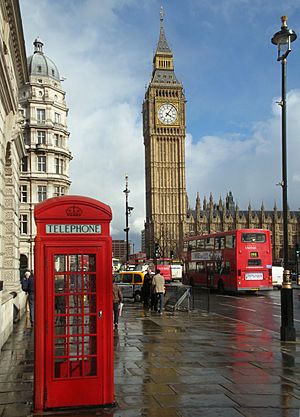Culture of London facts for kids
London is a super exciting city, known as one of the world's top cultural capitals! The culture of London is all about its amazing music, cool museums, fun festivals, and the unique way people live there. London is the capital city of the United Kingdom.
The city is famous for its awesome theatre scene, especially the West End theatre district. This area is so well-known that "West End theatre" is a special name for the big, professional shows put on in London. You can also find famous places like the British Museum, the Tate Galleries, the National Gallery, the lively Notting Hill Carnival, and The O2 arena.
London has a buzzing nightlife with lots of music, comedy, and theatre shows. Many famous landmarks are linked to London, like Big Ben, Buckingham Palace, and the unique tube map. Other British symbols you might know, like the red telephone box, the red AEC Routemaster bus, the black taxi, and the Union Flag, are also strongly connected to London.
London is home to people from all over the world. This mix of cultures has made the city's culture even richer and more interesting over time.
Contents
Music in London
London is a fantastic place for music lovers, with everything from classical concerts to modern pop and rap.
Classical Music and Opera
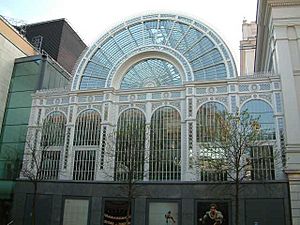
London has three main concert halls where you can hear amazing classical music. The Barbican Hall is home to the London Symphony Orchestra (LSO) and BBC Symphony Orchestra. The Royal Festival Hall at the South Bank Centre hosts the London Philharmonic Orchestra (LPO) and the Philharmonia. The biggest venue is the Royal Albert Hall, which puts on the famous BBC Proms every summer. The Royal Philharmonic Orchestra (RPO) also plays in London.
Many choirs from London sing beautiful music, from large groups like the London Philharmonic Choir to church choirs at places like St Paul's Cathedral and Westminster Abbey.
For opera and ballet, the Royal Opera House at Covent Garden is where you'll find the Royal Opera and the Royal Ballet companies. Another major opera company, the English National Opera, performs at the London Coliseum.
Popular Music
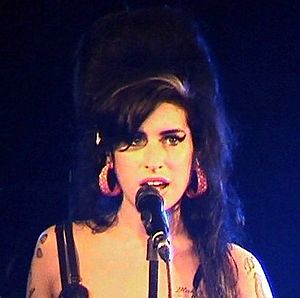
London is famous for its rock music scene. Many legendary bands started here in the 60s and 70s, like David Bowie, Iron Maiden, The Clash, Led Zeppelin, Pink Floyd, Queen, and The Who. Later, bands like Blur and Coldplay became popular. Big music tours often stop in London at venues like the Brixton Academy, the O2 Arena, and the Hammersmith Apollo.
London has also been a base for global superstars like The Beatles and Elton John. It was also important for the start of dance music.
The city has produced many successful pop acts too, including the Spice Girls, The Rolling Stones, One Direction, and Little Mix.
In the 21st century, London's urban music scene has grown a lot. Soul singers like Amy Winehouse and Lemar became very popular. R&B artists such as Adele, Dua Lipa, and Leona Lewis are also huge stars. London also has a strong rap scene, with artists like Wiley and Dizzee Rascal making it one of the best outside the US.
London is also known for its amazing underground music scenes, with genres like UK garage, drum and bass, dubstep, and grime.
Festivals in London
London hosts many festivals, fairs, and carnivals throughout the year. There are over 40 free festivals each year! The most famous is the Notting Hill Carnival, which is the second largest carnival in the world. It happens over the August bank holiday weekend and attracts nearly a million people. It has a strong Afro-Caribbean feel, with highlights like a competition between London's steelpan bands and a huge street parade with dancing and music.
London also has the Carnaval Del Pueblo, Europe's biggest Latin American Festival. It takes place on the first Sunday of August, with countries participating in a street procession that ends in Burgess Park.
There are also big parades for Saint George's Day (April 23) and Saint Patrick's Day (March 17). The Dance Umbrella festival in October features many dance groups performing across London.
Theatre and Dance

London has over three dozen major theatres, mostly in the West End. These "West End theatres" mainly show popular Musical Theatre shows, but you can also find comedies and serious plays.
There are also many non-commercial theatres, like the National Theatre and Shakespeare's Globe on the South Bank. The Barbican and the Royal Court Theatre (which focuses on new plays) are also important. The Royal Shakespeare Company also performs seasons in London.
London also has a thriving dance scene. Two main ballet companies, the Royal Ballet and English National Ballet, perform here. Sadler's Wells Theatre is a special place that shows dance performances all year, from modern dance to ballet.
Film in London
London is often used as a place to film movies and as a setting for stories. You can see it in historical films about Victorian London, like those featuring Charles Dickens or Sherlock Holmes. It's also in romantic comedies like Bridget Jones's Diary and Notting Hill. London has been featured in crime films, spy thrillers, science fiction movies, and the "swinging London" films of the 1960s.
Because London is so important in British media, many British films are set there. It has also appeared many times in American films, sometimes even recreated in Hollywood studios!
Museums and Art Galleries

London has over 240 museums, galleries, and other cultural places. Many of them are free to enter and are huge tourist attractions. They also play a big role in research.
The first major museum was the British Museum in Bloomsbury, started in 1753. It originally held old treasures, natural history items, and the national library. Now, it has 7 million items from all over the world! The Royal Academy of Arts also started in the 1700s, and its summer art exhibition has been a popular event since 1769.
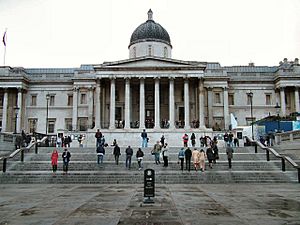
In 1824, the National Gallery, London, was founded to show British and Western art up to 1900. It's now a famous landmark in Trafalgar Square.
Other important art collections include The Wallace Collection, the Courtauld Gallery, and Dulwich Picture Gallery. For art from after 1900, you can visit Tate Modern. Tate Britain has a collection of British art. The National Portrait Gallery features portraits of important British people from all periods.
For modern art, besides Tate Modern, you can check out places like White Cube and the Saatchi Gallery.
In the late 1800s, the South Kensington area became "Albertopolis", a hub for culture and science. Three major national museums are there: the Victoria and Albert Museum (for art and design), the Natural History Museum (with its dinosaur skeletons!), and the Science Museum (full of cool inventions).
London also has many smaller, interesting museums. The Dulwich Picture Gallery was the first public art gallery built specifically for that purpose in England, opening in 1817. The Soane Museum is the amazing house of an architect, turned into a museum. The Museum of London tells the story of the capital's history, and a sister museum focuses on the city's port history.
Libraries in London
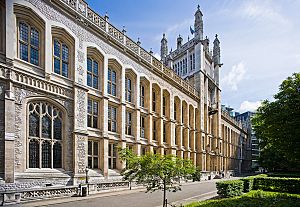
The British Library, located in St Pancras, is the largest library in the world! It's the national library of the UK and holds copies of almost every book published in the country.
London has many local public libraries, with each area having its own system. There are also private libraries and many research libraries, like the Wellcome Library. Plus, many universities have their own large libraries, such as the Maughan Library at King's College.
Nightlife in London
Beyond pubs and clubs, London has many music venues. Some well-known ones include Shepherd's Bush Empire, Brixton Academy, Hammersmith Apollo, and Wembley Arena. London is also home to famous clubs like the Ministry of Sound.
London has many welcoming spaces for everyone to enjoy the nightlife, including comedy clubs. Comedy is very popular, with around 100 venues showing different types of comedy. The Comedy Store is one of the oldest comedy venues in the world.
Sport in London
London is home to many professional sports teams and has hosted major international sporting events. It has even hosted the Summer Olympics three times: in 1908, 1948, and 2012.
Football is super popular here. London has Wembley Stadium, which is famous for big matches, as well as club stadiums like the Emirates Stadium (home of Arsenal), Stamford Bridge (home of Chelsea), and Tottenham Hotspur Stadium.
You can also find famous Cricket grounds like Lord's and The Oval. Rugby league and rugby union are also popular team sports. The famous The Boat Race (a rowing race between Oxford and Cambridge universities) and the Wimbledon Championships (a major tennis tournament) both happen in London. The Olympic Stadium hosts athletics events.
London's Cultural Influence
London's long history and fame mean it's often shown in movies, TV shows, and books. Because of this, many travelers come to London to experience its culture. Cultural tourism brings in a lot of money for London's economy and supports many jobs. London is promoted as a cultural center to attract even more tourists from around the world.


